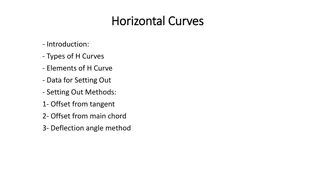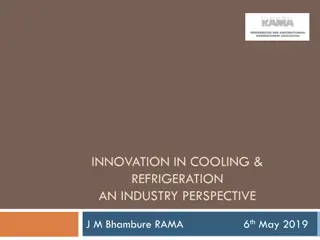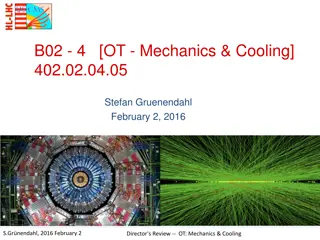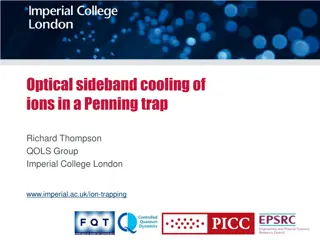Protocol: Cooling Basics, Clinical Considerations, and Phases of Care
The essentials of cooling protocols and clinical considerations, focusing on temperature management, thermoregulation basics, effects of hypothermia/cooling, central temperature measurement, and factors influencing target temperature. It emphasizes the importance of safe monitoring and application o
2 views • 72 slides
Cryogenic Sub-systems
Explore the relationship between liquefaction, refrigeration, and isothermal processes in accelerator systems. Understand the equivalent exergy in Watts for different gases at 1 bar and 300K. Calculate the reversible input power required for latent cooling and the total cooling in different scenario
1 views • 9 slides
Coolclean Cooling Tower Service Benefits
Coolclean carry out comprehensive cooling tower servicing to not just clean, but to also ensure that the cooling tower cools to its maximin efficiency, to reduce water and chemical usage, to reduce electrical power consumption, to reduce environmental damage, to control bacteria growth, and comply w
1 views • 3 slides
Advanced Microbunched Electron Cooling for EIC Design Overview
Microbunched electron cooling is a cutting-edge technique proposed for the Electron-Ion Collider (EIC) design, aimed at enhancing beam properties through coherent electron interactions. The concept utilizes Coherent Electron Cooling (CeC) and broad-band amplification in the form of Micro-bunched Ele
1 views • 16 slides
Advanced Cooling Solutions for Immersion Servers by Asperitas
Asperitas offers an innovative immersion cooling solution for servers, featuring the AIC24-15/19/21 technology with advanced power and compute densities. The integration solution includes power delivery, management, cooling, monitoring, and containment features for optimal performance. Their Shell I
1 views • 19 slides
Understanding Engine Cooling Systems
The cooling system in an engine is vital for maintaining optimal operating temperatures, preventing overheating, and ensuring efficient combustion. There are different types of cooling systems such as air cooling and liquid cooling, each with its advantages and disadvantages. Air-cooled engines rely
0 views • 23 slides
Understanding Horizontal Curves in Road Design
Horizontal curves are essential in road design to safely change alignment or slope. This article covers types of horizontal curves, setting out methods, geometric shapes of curves, and elements such as PI point, PC point, and radius. Learn why curves are crucial for modern highways and how different
0 views • 25 slides
Understanding ROC Curves in Multiclass Classification
ROC curves are extended to multiclass classification to evaluate the performance of models in scenarios such as binary, multiclass, and multilabel classifications. Different metrics such as True Positive Rate (TPR), False Positive Rate (FPR), macro, weighted, and micro averages are used to analyze t
3 views • 8 slides
Efficient Greenhouse Cooling Systems for Smart Agriculture
Active summer cooling systems like fan-and-pad and fog systems are crucial for maintaining optimal temperatures in greenhouses. These systems work by utilizing evaporation to remove heat from the air. Fan-and-pad cooling systems have been in use since 1954, where water is passed through pads to cool
1 views • 23 slides
Global Scenarios of Residential Heating and Cooling Energy Demand
This study presents global scenarios of residential heating and cooling energy demand and CO2 emissions, focusing on the evolution of building stock, energy demand, and emissions for space heating and cooling. The research aims to address the limitations in current global scenario studies by develop
8 views • 5 slides
Geometric Design of Highway Vertical Curves and Criteria
This content covers the vertical alignment in transportation engineering, focusing on the geometric design of highway facilities, specifically vertical curves like crest and sag curves. It explains the main design criteria for vertical curves, including minimum stopping sight distance provision, dra
2 views • 24 slides
Cooling Water Systems in Construction: Overview and Risk Management
Understanding the operation of cooling water systems in construction, specifically focusing on cooling towers and their usage in Tunnel Boring Machines (TBMs). Importance of proper maintenance to prevent the growth of Legionella bacteria and mitigate the risk of Legionnaires' disease. The process of
0 views • 6 slides
Understanding Petroleum Fraction Distillation Curves
Characterization and properties of petroleum fractions are essential for understanding their behavior, particularly through distillation curves. These curves depict the boiling points of crude oil or petroleum fractions, highlighting components' volatility ranges. Various methods like ASTM D86, True
0 views • 28 slides
Overview of Aquaflair and Uniflair Chillers
The AquaflairERACERAHERAF1 series features state-of-the-art technology for maximum reliability and efficiency. With cooling capacities ranging from 50 to 110 kW, these chillers utilize environmentally friendly R410A refrigerant and electronic thermostatic valves for energy efficiency. The ERAC, ERAH
0 views • 96 slides
Understanding Indifference Curve, Budget Line, and Consumer Equilibrium
Indifference curves and budget lines are essential concepts in economics to analyze consumer behavior and preferences. Dr. Pooja Singh, an Assistant Professor at Chhatrapati Shahu Ji Maharaj University, Kanpur, explains how indifference curves represent different combinations of goods that offer the
0 views • 9 slides
District Cooling Trends and Companies in Finland
Explore the latest developments in district cooling in Finland, including the increase in connected load and energy production capacity. Discover how energy companies are contributing to the growth of district cooling services. Learn about the innovative production methods and energy sources utilize
0 views • 8 slides
Understanding Quantitative Aspects of Drug Action
Explore the quantitative aspects of drug action, including drug receptor binding, concentration binding curves, dose-response curves, and types of antagonism. Learn to relate drug concentration to receptor binding capacity and response produced. Discover how concentration binding curves and dose-res
0 views • 29 slides
Understanding Various Types of Frequency Curves in Statistics
Explore different types of frequency curves such as symmetrical, moderately skewed, extremely skewed, and U-shaped curves. Symmetrical curves exhibit mirror images on either side, while skewed curves have longer tails on one side. Extreme skewness results in J-shaped or reverse J-shaped curves. The
0 views • 8 slides
Robust Parity Test for Extracting Parallel Vectors in 3D
Fundamental primitives for visualizing 3D data include line features like ridges and valleys of a scalar field, stream lines of a vector field, vortices of a velocity field, and extremal curves of a tensor field. Parallel Vectors (PV) provide a unified representation of 3D line features, forming con
0 views • 27 slides
Automated Tool for Inventorying and Characterizing Horizontal Curvature in Roadways
Improving highway safety is a priority for transportation departments. This project aims to develop a tool that automates the identification and characterization of horizontal curves in roadway networks using GIS technology. Roadway curvature, including horizontal curves, plays a key role in predict
1 views • 26 slides
Understanding Supply and Demand in a Competitive Market
This content delves into the concept of supply and demand in a competitive market as described by the renowned economists Paul Krugman and Robin Wells. It covers the basics of a competitive market, the dynamics of supply and demand curves, movements along curves, market equilibrium, and how prices a
0 views • 42 slides
Polar Curves: Intersections, Areas, and Calculating Enclosed Areas
Explore polar curves, their intersections, areas enclosed by curves, and calculating enclosed areas using given equations. Learn to sketch graphs, find points of intersection, polar coordinates, and apply formulas for finding enclosed areas with examples provided.
0 views • 21 slides
Simulation of Stratospheric Temperature by GFDL Models: Observations and Trends
Interannual variations of stratospheric temperature since 1979 are well simulated by GFDL models, showing general cooling trends, stronger cooling over Southern Hemisphere high latitudes, post-eruption warming, delayed cooling after eruptions, and flat trends in the 2000s. However, models tend to ov
0 views • 10 slides
Understanding Temperature Structure and Cumulative Heating/Cooling in Atmospheric Boundary Layer
The temperature structure in the atmospheric boundary layer (ABL) is influenced by cumulative heating or cooling effects from the surface. During the day, heat accumulates within the ABL, while cooling occurs at night. The cumulative heating or cooling is more crucial for ABL evolution than instanta
0 views • 12 slides
Understanding B-Spline Curves in Computer Graphics
Exploring the advantages of B-spline curves over Bezier curves, this content delves into the representation, calculation of basis functions, and properties of B-spline curves. The discussion includes issues with Bezier curve representation, local control in B-spline curves, and the subdivision of th
0 views • 11 slides
Advanced Cooling Solutions: ACS Cold Plate Focus Areas
Introduction to ACS Cold Plate focus areas led by Jessica Gullbrand from Intel. The objective is to standardize liquid-cooled solutions without hindering innovation. The ongoing focus includes approval of cold plate requirements, initiation of Open Rack V3 Blind Mate Liquid Cooling, and various work
0 views • 20 slides
Cooling Strategies for Low-Income Customers in California
Learn about PG&E's initiatives to provide cooling strategies for low-income customers, including CARE funds for Cooling Centers and ESA-provided Cooling Measures. Regulatory guidance ensures long-term energy consumption reductions without burdening low-income ratepayers. Find out what Cooling Center
0 views • 12 slides
Advancements in Neutron Cooling Techniques and Paramagnetic Systems
The presentation discusses cascaded cooling of neutrons and Namiot's proposal for phononless cooling to low temperatures using polarized deuterons. It explores inelastic scattering cross-sections, candidate paramagnetic systems, and excitations in O2. Additionally, it covers rate constants, superflu
0 views • 11 slides
Innovation in Cooling & Refrigeration: Industry Challenges and Opportunities
This presentation explores the current state of cooling and refrigeration in India, highlighting the significance of innovative technologies in addressing the growing demand for efficient cooling solutions. The discussion includes insights on India's climate zones, cooling needs, refrigeration deman
0 views • 13 slides
Understanding Vertical Alignment in Railway Track Geometric Design by Dr. Walied A. Elsaigh
Explore the vertical alignment of railway tracks through Dr. Walied A. Elsaigh's insights on curve length formulas, types of crest and sag vertical curves, properties of typical vertical curves, and a detailed example with solutions for calculating elevations at various stations along the curve. Lea
0 views • 10 slides
Director's Review - Mechanics & Cooling Overview
The US will design and build the central portion of the Phase 2 Tracker Barrel Pixel Strip Detector (TBPS), focusing on mechanics and cooling. The project involves three layers of PS modules with specific lengths, utilizing carbon fiber/carbon foam sandwich planks with embedded CO2 cooling. Collabor
0 views • 19 slides
Understanding Evaporative Cooling and Cooling Towers in Energy Management
Dive into the world of evaporative cooling and cooling towers with this detailed chapter. Learn about direct and indirect cooling processes, psychrometric phenomena, range and approach in cooling systems, different airflow arrangements in cooling towers, and the theory behind evaporative cooling. Di
0 views • 20 slides
Versatile Tests for Comparing Survival Curves Based on Weighted Log-Rank Statistics
Overview of various statistical tests for comparing survival curves beyond the traditional log-rank test. The focus is on weighted log-rank statistics sensitive to non-proportional hazards scenarios, with examples and methodologies discussed. These tests aim to provide more nuanced insights into dif
0 views • 31 slides
Comparing Cooling Curves of Different Liquids at 70°C
The activity involves heating different liquids to the same temperature (70°C) and comparing their individual cooling curves to understand their specific heat capacities. Students create hypotheses about the heat release during cooling, test them using temperature sensors, and explore how molecular
0 views • 23 slides
Real-Time Co-optimization of Energy & Ancillary Services Demand Curves
Explore the concept of constructing demand curves for Regulation Up Service, Regulation Down Service, and Responsive Reserve Service from the ERCOT public data. Learn about modifying individual AS demand curves and allowing overlaps to enhance co-optimization and efficiency. Dive into an example AS
0 views • 17 slides
Welding Heat Flow and Cooling Rate Calculations
Understanding welding heat flow and cooling rate calculations is essential for determining the critical cooling rate in welding processes. Factors such as plate thickness, number of passes, and relative plate thickness play a crucial role in selecting the appropriate equations for calculating coolin
0 views • 10 slides
Simulation of Cooling System for PANDA Electromagnetic Calorimeter
A detailed study on optimizing cooling system design for the PANDA electromagnetic calorimeter using Computational Fluid Dynamics (CFD) to enhance temperature stability and light yield efficiency. The simulation focuses on factors like cooling tube arrangement, mass flow rate, and fluid properties i
0 views • 11 slides
Optical Sideband Cooling of Ions in a Penning Trap - Research Summary
Researchers at Imperial College London, led by Richard Thompson, have made significant contributions in the field of optical sideband cooling of ions in a Penning trap. This technique involves laser cooling in the trap, large Lamb-Dicke parameters, sideband cooling of ions, coherent manipulation of
1 views • 34 slides
Understanding Dose-Response Curves in Pharmacology
Dose-response curves play a crucial role in pharmacology by illustrating the relationship between drug dosage and its effects. Researchers use these curves to determine potency, efficacy, and safety of drugs, helping to establish the required dose for desired outcomes. By comparing pharmacologic pro
0 views • 13 slides
Understanding Quantitative Aspects of Drug Action
Explore the quantitative aspects of drug action, including drug receptor binding, dose-response curves, therapeutic utility, and types of antagonism. Learn about drug affinity, efficacy, potency, and the relationship between drug binding and concentration. Discover how concentration-binding curves a
0 views • 18 slides







































